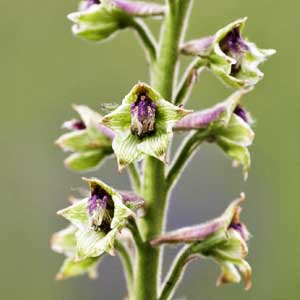Delphinium viridescens
Delphinium inopinum
Wenatchee larkspur
unexpected larkspur
90-150 cm;
base usually green, glabrous.
70-110(-150) cm;
base reddish or not, glabrous, often glaucous.
blade cuneate to semicircular, 2-5 × 3-12 cm, nearly glabrous; ultimate lobes 3-21, width 1-8 mm.
blade ± pentagonal, 1-5 × 1.5-7 cm, glabrous; ultimate lobes 3-9, width 5-28 mm (basal), 3-18 mm (cauline).
25-80-flowered, dense;
pedicel 0.5-2 cm, glandular-pubescent;
bracteoles 1-4 mm from flowers, green, lanceolate, 3.5-6 mm, glandular-pubescent.
20-35(-51)-flowered, usually dense;
pedicel 0.3-1.5(-2.5) cm, glabrous;
bracteoles 2-4 mm from flowers, green, linear, 1-2(-4) mm, nearly glabrous.
sepals yellowish green, nearly glabrous, lateral sepals forward pointing, 7-9 × 3-4 mm, spurs decurved, 30-45° below horizontal, often hooked apically, 8-11 mm;
lower petal blades ± covering stamens, 4-6 mm, clefts 0.5-1.5 mm;
hairs centered, mostly near junction of blade and claw, yellow.
sepals white to light blue, glabrous, lateral sepals spreading to forward pointing, 8-12 × 3-5 mm, spurs straight to gently upcurved, ascending 30-60° above horizontal, 9-12 mm;
lower petal blades slightly elevated, ± exposing stamens, 3-5 mm, clefts 1-2 mm;
hairs centered, densest near base of cleft, white.
8-11 mm, 2.5-3 times longer than wide, puberulent.
12-20 mm, 2.6-4 times longer than wide, glabrous.
± wing-margined;
seed coat cells with surfaces ± roughened.
wing-margined;
seed coat cells surfaces smooth.
Delphinium viridescens
Delphinium inopinum
Of conservation concern.
Delphinium viridescens is local in mountains southwest of Wenatchee, Washington.
(Discussion copyrighted by Flora of North America; reprinted with permission.)
Delphinium inopinum is apparently endemic to a white metamorphic rock substrate in the Piute Mountains and southern Sierra Nevada. It is not known to hybridize with any other species, although D. patens subsp. montanum has been collected (when both were flowering) within 1 km of D. inopinum and probably occurs much closer. Delphinium inopinum is often confused with D. parishii subsp. pallidum and superficially resembles some white-flowered individuals of D. hansenii, as well as D. gypsophilum and D. hesperium subsp. pallescens. The massive roots with prominent buds readily distinguish D. inopinum from all of these. In addition, the pubescence found on D. hansenii will separate it from the glabrous D. inopinum. Leaves are rarely seen at anthesis near the base of the stem in D. hesperium subsp. pallescens; they are present in D. inopinum.
(Discussion copyrighted by Flora of North America; reprinted with permission.)


